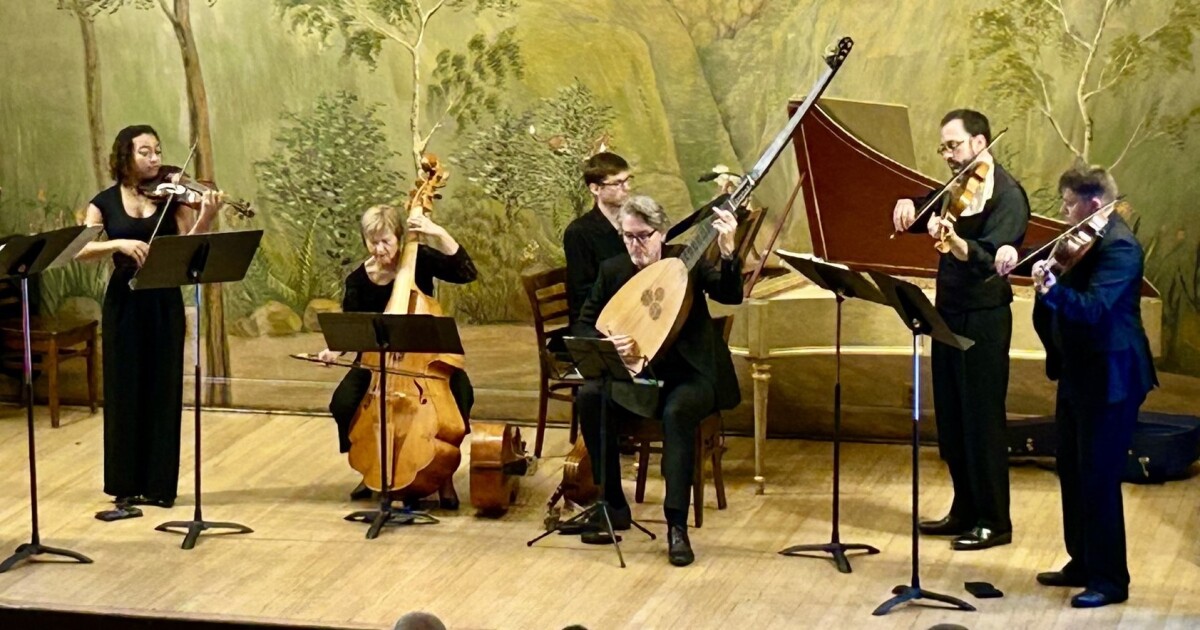This is WESA Arts, a weekly newsletter by Bill O’Driscoll providing in-depth reporting about the Pittsburgh area art scene. Sign up here to get it every Wednesday afternoon.
Amid the widespread continued post-pandemic slump in performing arts attendance, one bright spot has been live music. Through last year, the biggest touring acts had set box office records three years running.
Those multibillion-dollar totals for arena and stadium shows — your Coldplays, your Taylor Swifts — do not account for concerts at neighborhood clubs, let alone performances in non-pop genres. But at least one Pittsburgh nonprofit specializing in the sounds of the baroque era has been quietly building its audience even as it looks toward the future with new leadership.
Chatham Baroque this week announced that Scott Pauley, long one of the group’s three principal musicians, has assumed the newly created role of managing and artistic director. Longtime artistic director Donna Goyak will become a part-time senior advisor.
Though it’s in part a cost-saving move, it comes as Chatham Baroque, in its modest way, continues to defy the trend that’s found so many other performing arts nonprofits struggling to fill seats.
The group this season to date has 187 subscribers, up 11% from last year. Better still, about 30% are first-time subscribers, a development Goyak calls “really extraordinary.”
Musically, Chatham Baroque, founded in 1990, consists of Pauley, Andrew Fouts and Patricia Halverson. They play music from about 1600 to 1750 — think Bach, Vivaldi, Handel — on period instruments. Fouts plays violin while Halverson plays viola da gamba, which resembles a six-stringed cello. Pauley handles baroque guitar and theorbo, the latter a sort of lute with an extra-long neck.
The group is unusual in that it performs in many venues around town, from houses of worship like Shadyside Presbyterian and Rodef Shalom to Oakland’s Carnegie Music Hall. In 2018, Chatham Baroque merged with the Renaissance & Baroque Society of Pittsburgh, known primarily for presenting touring musicians. This season, the group will produce seven shows, most performed by the Pittsburgh-based musicians but a few featuring touring talent like Czech a capella ensemble Tiburtina.
That’s up from five shows a season Chatham Baroque did before the merger, no small feat when some local theater troupes have shrunk their performance calendars.
Chatham Baroque’s success in recent years should be kept in perspective. That 11% rise in subscribers represents only 18 more buyers than last year. And while April’s ambitious world premiere of a reconstructed Bach classic drew the group’s largest single audience ever — 700 souls at Carnegie Music Hall — total attendance for all events last season was about 4,200, the equivalent of one good weekend for the Pittsburgh Symphony at Heinz Hall.
Like most nonprofit arts groups, Chatham Baroque leans heavily on contributed revenue: Goyak says about two-thirds of its roughly $500,000 budget comes from foundations, government support and individual donors, with just one-third from ticket sales and other earned income. With funds from foundations and government expected to stand pat, at best, work remains to be done.
Still, what’s behind the encouraging turnout?
The group isn’t entirely sure. Three-quarters of its subscribers are seniors, suggesting Chatham Baroque faces the same aging-audience challenge as so many other groups. (Though there seems to be a renewable supply of “aging audiences”: As Goyak points out, “We were having this same conversation 30, 40 years ago.”)
The group credits some of its support to things like its marketing and social media efforts, but also to elements baked into the programming, especially its commitment to neighborhood venues.
Goyak theorizes that pre-pandemic, people were more interested in a fancier Downtown arts experience. Now, she says, “It seems people are discovering they can come as they are” to neighborhood spots. (For any given week’s program, each of the group’s three performances might take place at a different venue.) The tickets and parking are typically cheaper and the shows are often briefer.
“My general sense is, people are valuing slightly different things these days,” Goyak says.
Baroque music’s era as a contemporary art form had already faded when the first stones were laid for Fort Pitt (ca. 1759). It would seem to face an uphill battle in the age of the algorithm. But board president Sharon Steele says the challenge is less that people haven’t heard baroque music than that they don’t think of it as something anyone still performs.
She says she once sat next to a young audience member who recognized one composition from a video game. And this year she met a young man who said his No. 1 artist on Spotify last year was Bach, but who’d never heard of Chatham Baroque. “Follow them on Instagram,” she told him.
So perhaps Chatham Baroque fans do share something after all with the folks at those sold-out stadiums and arenas.
As Steele says, “There’s a need out there for people to have these real-life musical experiences.”

